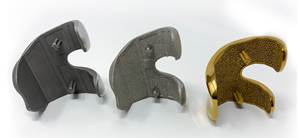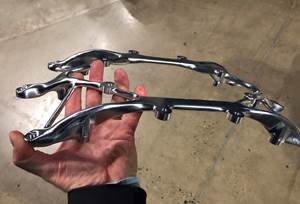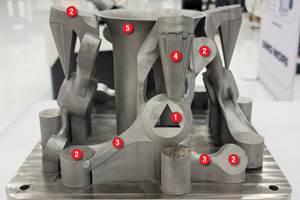Gosiger Adds 3D Printing Equipment, Services via Stratasys
The technology provider and integrator is helping to bring 3D printing to the shop floor via a new product line and partnership.

Machine tool distributor and systems integration expert Gosiger recently announced a new agreement to supply and service Stratasys 3D printers. The move is a natural advance for the company, whose customers are increasingly showing interest in additive manufacturing. However, the move is also strategic on the part of the 3D-printing equipment builder. Stratasys sees the future of its equipment not primarily among home or hobbyist users (though that might be a part of it) but instead in manufacturing facilities. The goal—for both Gosiger and Stratasys—is to help advance AM into applications out on the shop floor, and even into production.
As Josh Claman, chief business officer for Stratasys, put it: “The history of 3D printing is design and prototyping. The future is that, plus manufacturing.”
Claman addressed an audience at 3D4U, an event hosted at Gosiger’s Dayton, Ohio, headquarters shortly after the initial announcement was made. The June 14 open house and keynote presentation was a chance for Gosiger customers to learn about Stratasys technology as well as an opportunity for Stratasys to articulate its vision for additive manufacturing as a valuable tool for shopfloor applications as well as design and prototyping functions. Partnering with Gosiger provides necessary relationships and manufacturing expertise to help achieve that vision.
From Gosiger’s perspective, supplying 3D printing equipment is another way to serve its customers in addition to the machine tools, robotics, inspection equipment and complete turnkey systems it already provides. The company also sees great potential for using its own Stratasys machines to produce custom objects for its clients such as jigs and fixtures.
“As we expose our engineers to this technology, they are coming up with new ideas daily,” says John Haley, Gosiger CEO.
A number of sample components were on display during the 3D4U event, including some from Stratasys, but also many that were created by Gosiger employees following training on Stratasys 3D printers. These parts illustrate some of the services that Gosiger can provide with its new 3D printing capacity—and they may inspire customers to seek 3D printers of their own. A few examples of these applications are pictured below:
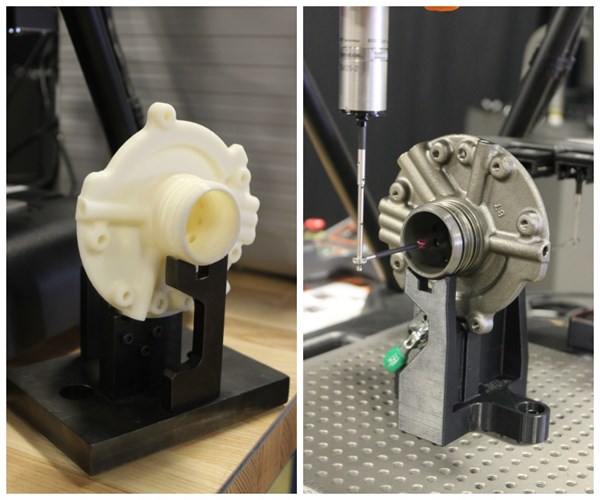
Gosiger frequently supplies machined custom fixtures for workholding and inspection. A metal CMM fixture such as the one on the left (holding the 3D-printed model stator) might cost upwards of $600 and take a week at a machine shop. The 3D-printed fixture (on the right) cost only $82 and was produced within a day on a Stratasys 450mc.
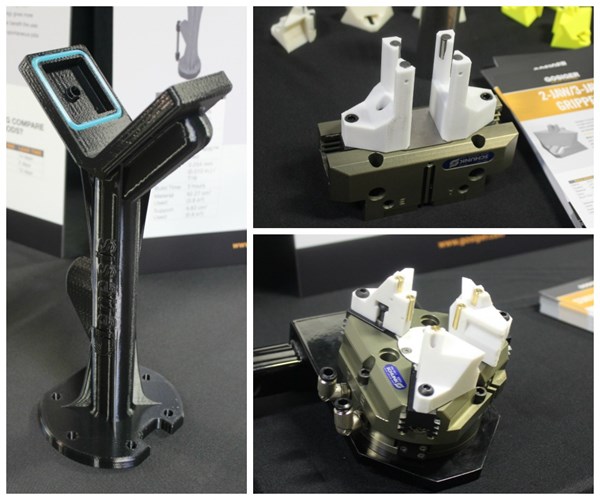
Robotic arms are another key component that Gosiger supplies, often as part of larger robot-tended cells. Custom grippers tailored to the customer’s application are commonly part of the package. Tools such as vacuum end effectors (like the one on the left) and jawed grippers (right) can be created and produced faster and more cost-effectively with a 3D printer than they can be machined. As an added benefit, they are also lighter than machined grippers.

1.3D-printed models can help speed the setup of CMMs and other systems. This model of an injection-molded vacuum cleaner component as well as the fixture it is resting on were 3D printed so that a CMM could be programmed before the actual parts arrived, reducing the quality control setup time from about a month to just one day.
Related Content
4 Ways 3D Printing Is Changing Medical Implants
Additive manufacturing provides new ways of making medical implants, but its impact is greater than this. How 3D printing is changing medical manufacturing and improving patient outcomes.
Read MoreThe Benefits of Vertically Integrating Metal 3D Printing and Machining
Having 3D printing and machining within one organization enables Addman’s engineers to collaborate and consolidate so it can quickly make successful metal 3D printed parts.
Read MoreUsing Topology Optimization to Lightweight: A Paradox for Machining
Today’s computer software can just as easily generate lightweight shapes for subtractive processes as it can for additive ones, but it increases cost and waste to make them.
Read MoreDesigning a 3D Printed Part with Machining in Mind
Designing extra stock and mounting features into a 3D printed part can aid in machining processes downstream.
Read MoreRead Next
The Cut Scene: The Finer Details of Large-Format Machining
Small details and features can have an outsized impact on large parts, such as Barbco’s collapsible utility drill head.
Read MoreObscure CNC Features That Can Help (or Hurt) You
You cannot begin to take advantage of an available feature if you do not know it exists. Conversely, you will not know how to avoid CNC features that may be detrimental to your process.
Read More3 Mistakes That Cause CNC Programs to Fail
Despite enhancements to manufacturing technology, there are still issues today that can cause programs to fail. These failures can cause lost time, scrapped parts, damaged machines and even injured operators.
Read More
.jpg;width=70;height=70;mode=crop)












.png;maxWidth=300;quality=90)
.png;maxWidth=300;quality=90)




